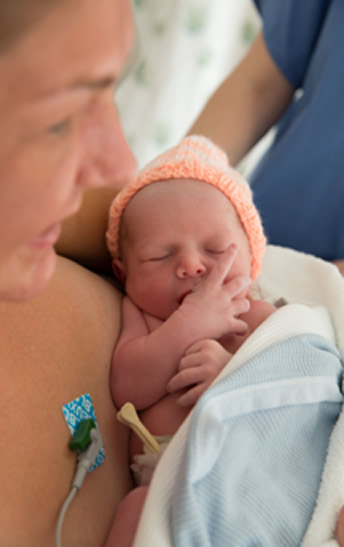
Vaginal Birth
Vaginal birth is the delivery of a baby from the uterus (womb), out through the vagina.
In NHS Lothian around 43% of babies were born this way in 2023.
Assisted Birth
An assisted or instrumental birth is where forceps or a ventouse suction cup are used to help deliver the baby. This can be because:
- there are concerns about your baby’s heart rate
- your baby is not in an ideal position
- you’re too exhausted
Occasionally they might be performed for some women for whom the length of the second stage of labour should be limited, for example if you have certain cardiac conditions.
In NHS Lothian around 14% of babies were born this way in 2023.
Both ventouse and forceps interventions are carried out by doctors who have had training and only used when necessary for you and your baby.
Sometimes, as the baby is being born, an episiotomy may be needed to make the vaginal opening bigger. Any tear or cut will be repaired with dissolvable stitches. Your midwife or doctor will ensure you have appropriate pain relief for this procedure.
Depending on the circumstances, your baby can be delivered and placed onto your tummy, and your birthing partner may still be able to cut the cord if they want to.
A neonatologist should be present at the birth to check your baby’s condition after the birth.
Ventouse
A ventouse (vacuum extractor) is an instrument that is attached to the baby’s head by suction. A soft or hard plastic or metal cup is attached by a tube to a suction device. The cup fits firmly onto your baby’s head. During a contraction and with the help of your pushing, the obstetrician gently pulls to help deliver your baby.
The suction cup leaves a swelling on your baby’s head, called a chignon. This will disappear over the next few days. The cup may also leave a bruise on your baby’s head. This will also disappear over the next few days.
Forceps
Forceps are smooth metal instruments that look like large spoons or tongs. They’re curved to fit around the baby’s head. The forceps are carefully positioned around your baby’s head and joined together at the handles. With a contraction and your pushing, an obstetrician gently pulls to help deliver your baby.
There are many different types of forceps. Some forceps are specifically designed to turn the baby to the right position to be born, for example, if your baby is lying facing upwards or to one side.
Forceps can leave small bruises on your baby’s face but these will disappear quite quickly.
Caesarean Birth (C-section)
A Caesarean Birth, or C-section, is an operation to deliver your baby through a cut made in your tummy and womb.
In NHS Lothian around 43% of babies were born this way in 2023.
The cut is usually made across your tummy, just below your bikini line.
You will be given an anaesthetic which will either be an epidural, spinal or combined spinal-epidural. Very occasionally a general anaesthetic is used (a general anaesthetic is when you are put to sleep).
A caesarean is a major operation that carries a number of risks, so it’s usually only done if it’s the safest option for you and your baby.
Planned Caesarean Section
If there are concerns for either you or your baby towards the end of your pregnancy, a planned caesarean (also called Elective C-section) will be offered. This is a pre-arranged caesarean which takes place before you go into labour.
In NHS Lothian around 16% of babies were born this way in 2023.
Enhanced Recovery for Obstetric Surgery in Scotland Planned Caesarean Birth Video
This short film has been developed by NHS Lothian to help prepare you before your caesarean birth, and focuses on advice and steps to take before your caesarean. You will also see what to expect in the operative room, as well as post-operative follow up to aid your recovery.
EROSS Planned Caesarean Section and Recovery
This second film was developed by NHS Scotland and also focuses the preparation and recovery steps for a planned caesarean birth.
An Unplanned Caesarean Birth is performed when there are concerns for you or your baby during labour.
Unplanned Caesarean Section
If there are concerns for you or your baby during labour, an Unplanned Caesarean Section can be performed.
In NHS Lothian around 27% of babies were born this way in 2023.
This video offers practical advice to recover well and move safely in and out of bed after a caesarean section (planned or unplanned).
Postoperative Physiotherapy Video
Giving birth in theatre
If your obstetrician has any concerns, you may be moved to an operating theatre in order that a caesarean birth can be carried out if needed, for example if the baby cannot be easily delivered by forceps or ventouse. Afterwards you may spend some time in the recovery or close observation area if you have gone to theatre, and your care will continue on the postnatal ward.
Types of Anaesthesia for Birth in Theatre
NHS Lothian have made a series of videos to provide you with useful information and to show you what to expect if you have an anaesthetic during or after the birth of your baby.
NHS Lothian Summary Video













